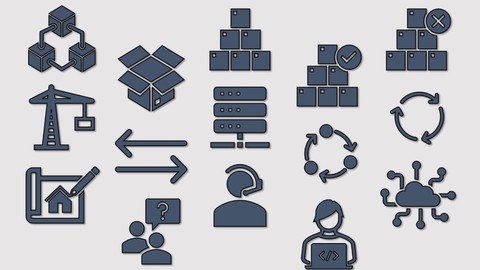
Software architecture
Software architecture, available at $59.99, has an average rating of 3.9, with 27 lectures, 4 quizzes, based on 462 reviews, and has 78111 subscribers.
You will learn about Acquaintance with different levels in software architecture Creation of the constituent parts of the software architecture and the connection between them Building the best software architectures Creation of an understandable description of the software architecture for further expansion This course is ideal for individuals who are A course for professionals who want to expand their knowledge of software architecture It is particularly useful for A course for professionals who want to expand their knowledge of software architecture.
Enroll now: Software architecture
Summary
Title: Software architecture
Price: $59.99
Average Rating: 3.9
Number of Lectures: 27
Number of Quizzes: 4
Number of Published Lectures: 27
Number of Published Quizzes: 3
Number of Curriculum Items: 31
Number of Published Curriculum Objects: 30
Original Price: $39.99
Quality Status: approved
Status: Live
What You Will Learn
- Acquaintance with different levels in software architecture
- Creation of the constituent parts of the software architecture and the connection between them
- Building the best software architectures
- Creation of an understandable description of the software architecture for further expansion
Who Should Attend
- A course for professionals who want to expand their knowledge of software architecture
Target Audiences
- A course for professionals who want to expand their knowledge of software architecture
The architecture describes the processes and structures of the entire project, determining the data throughput in different parts of the project, and allows you to optimize and scale the project in the future.
Good architects are often people who learn from even better architects. Perhaps this is because some conceptual requirements are inherent in almost all projects. Each conceptual requirement is formulated as a question that the architect must ask himself during the project. Of course, some systems may have their own additional critical conceptual requirements.
We will get to know the types of software architectures. We will be able to create our own simple software architecture. We will be able to use and expand the software architecture. As a result, this course will be useful not only for architects or people who plan to become one. And, technical leaders of the development group, developers of different levels and testers.
In first section, I reveal the main objective of the course. In second section you will be introduced to the types of software architectures. In third section you will be able to create his own simple software architecture. In forth section you will be able to use and extend the software architecture. In fifth section the nuances of software architecture will be considered. Six section will help you understand which part of the course will be most useful to you.
Course Topics and Structure:
1. Introduction
2. Familiarity with software architecture.
2.1 Introduction
2.2 Principles of software architecture.
2.3 The content of the architecture.
2.4 Static structural diagrams.
2.5 Dynamic diagrams.
2.6 Conclusions.
3. Creation of software architecture.
3.1 Introduction
3.2 How to start creating software architecture.
3.3 The interface and what it should describe.
3.4 Interaction of components and objects.
3.5 Database. Content, objects, interaction.
3.6 Dynamic diagrams, how to do and why you need them.
3.7 Conclusions.
4. Support and use of software architecture.
4.1 Introduction
4.2 What to do with the software architecture after its creation.
4.3 Helpful information for the programmer on software architecture.
4.4 Support of software architecture.
4.5 Extending the software architecture.
4.6 Conclusions.
5. Software architecture. Next level.
5.1 Introduction
5.2 Summary of the main structures.
5.3 Impact of software architecture on the future life of software.
5.4 A software architect is not a profession, but a calling.
5.5 Twelve architecture mistakes.
5.6 Conclusions.
6. Conclusions and results of the course. Summing up.
Course Curriculum
Chapter 1: Introduction
Lecture 1: Introduction lesson
Chapter 2: Acquaintance with the software architecture.
Lecture 1: Introduction lesson
Lecture 2: Elements of software architecture
Lecture 3: Architecture content
Lecture 4: Static structural diagrams
Lecture 5: Dynamic diagrams
Lecture 6: Summing up the section lesson
Chapter 3: Creation of software architecture.
Lecture 1: Introduction lesson
Lecture 2: How to start creating software architecture
Lecture 3: Interface and what should be described in it
Lecture 4: Interaction of components and objects
Lecture 5: Database. Content, objects, interaction
Lecture 6: Dynamic diagrams, how to make and why you need them
Lecture 7: Summing up the section lesson
Chapter 4: Support and use of software architecture.
Lecture 1: Introduction lesson
Lecture 2: What to do with software architecture after it is created
Lecture 3: Useful information for a programmer in software architecture
Lecture 4: Support of software architecture
Lecture 5: Extending software architecture
Lecture 6: Summing up the section lesson
Chapter 5: Software architecture. Next level.
Lecture 1: Introduction lesson
Lecture 2: Summary of major structures
Lecture 3: The impact of software architecture on the future life of software
Lecture 4: A software architect is not a profession, but a vocation
Lecture 5: Twelve architecture mistakes
Lecture 6: Summing up the section lesson
Chapter 6: Conclusions and results of the course.
Lecture 1: Summarizing
Instructors
-
ANDRII SVIATOBATKO
Software development on PLCs, MC, FPGAs, MA. Team lead.
Rating Distribution
- 1 stars: 19 votes
- 2 stars: 24 votes
- 3 stars: 55 votes
- 4 stars: 146 votes
- 5 stars: 218 votes
Frequently Asked Questions
How long do I have access to the course materials?
You can view and review the lecture materials indefinitely, like an on-demand channel.
Can I take my courses with me wherever I go?
Definitely! If you have an internet connection, courses on Udemy are available on any device at any time. If you don’t have an internet connection, some instructors also let their students download course lectures. That’s up to the instructor though, so make sure you get on their good side!
You may also like
- Top 10 Financial Technology Courses to Learn in December 2024
- Top 10 Agile Methodologies Courses to Learn in December 2024
- Top 10 Project Management Courses to Learn in December 2024
- Top 10 Leadership Skills Courses to Learn in December 2024
- Top 10 Public Speaking Courses to Learn in December 2024
- Top 10 Affiliate Marketing Courses to Learn in December 2024
- Top 10 Email Marketing Courses to Learn in December 2024
- Top 10 Social Media Management Courses to Learn in December 2024
- Top 10 SEO Optimization Courses to Learn in December 2024
- Top 10 Content Creation Courses to Learn in December 2024
- Top 10 Game Development Courses to Learn in December 2024
- Top 10 Software Testing Courses to Learn in December 2024
- Top 10 Big Data Courses to Learn in December 2024
- Top 10 Internet Of Things Courses to Learn in December 2024
- Top 10 Quantum Computing Courses to Learn in December 2024
- Top 10 Cloud Computing Courses to Learn in December 2024
- Top 10 3d Modeling Courses to Learn in December 2024
- Top 10 Mobile App Development Courses to Learn in December 2024
- Top 10 Graphic Design Courses to Learn in December 2024
- Top 10 Videography Courses to Learn in December 2024






















